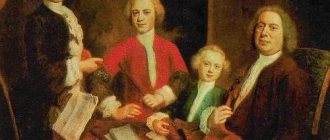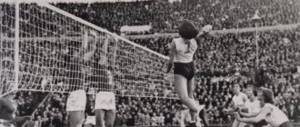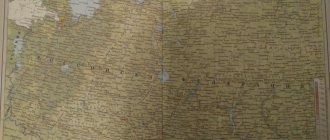Summary of a history lesson in 6th grade with presentation. The rise of the Russian state under Yaroslav the Wise
History lesson in 6th grade on the topic: “The heyday of the Russian state under Yaroslav the Wise”
Description : this development is intended for history teachers in secondary schools. This is a classic version of a combined lesson, which includes a variety of tasks, changing types of activities, working with electronic resources, historical documents, and variable homework. The lesson was prepared according to the textbook on the history of Russia, edited by. Danilova, Kosulina, 6th grade Since I work in a special school for children with visual impairments, special attention is paid to health care and preservation of residual vision. The lesson was developed by Elena Borisovna Zhdanova, teacher of history and social studies at Biysk secondary school - boarding school No. 3, Biysk, Altai Territory History lesson in 6th grade on the topic: “The heyday of the Russian state under Yaroslav the Wise” Purpose : introducing students to the peculiarities of the historical development of Russia in era of the reign of Yaroslav the Wise Objectives : 1. Correctional - educational Create conditions for students to understand the special role of Yaroslav Vladimirovich in the history of our country; introduce the history of his rise to power, the main directions of foreign and domestic policy, the peculiarities of government, the formation of patrimonial land ownership and different categories of the population. Explain to children the outstanding services of Yaroslav the Wise to our Fatherland 2. Correctional - developmental Ensure the development of general educational skills; the ability to analyze a historical document, work with textbook material, systematize and generalize the material, and draw the right conclusions. Develop dialogical and monologue speech, critical thinking, memory, logic, expand the vocabulary of words, develop reading techniques 3. Correctional - educational Promote the education of patriotism based on the topic being studied, respect for the history of one’s country, pride in the people who gave their lives for the good of the Fatherland . Develop mutual respect, the ability to listen to teachers and friends, communication skills and adequate self-esteem 4. Special Comply with sanitary and hygienic requirements for the lesson: wearing glasses, visual load mode, dynamic pauses, do exercises for the eyes Lesson equipment : computer, projector, multimedia presentation, handouts (documents, information cards, a sheet with the topic and lesson plan), tree of knowledge (prepare two-color leaves with questions for repetition and homework options); for the final result – cards and magnets for the board; electronic supplement to the textbook, textbook for 6th grade, edited by Danilov A.A. and Kosulina L.G. Main stages of the lesson 1. Organizational moment. Hello guys, hello guests! I am glad to welcome you to the history lesson. Today is a nice spring day, so I would like to ask: how are you feeling? Let me remind you that according to the Orthodox calendar, March 15 is the day of the holy martyr Fedot, who was the bishop of the city of Kyrenia in Cyprus. Fedot accepted torment and suffering for his faith, but Emperor Constantine granted freedom to Christians, after which Fedot served as a bishop and went to the Lord around 326. According to signs, on this day, instead of the expected thaw, there is frost, so they say: “Fedot, but not that one.” Fedot is evil - don’t be with the grass. There are sumyota (drifts) on Fedot. On this day, the German poet Paul Heise, the clown Leonid Engibarov, the writer Valentin Rasputin, and the actress Eva Longoria were born. In history, the Russian Empress Anna Ioannovna dissolved the Supreme Privy Council, the construction of the Mikhailovsky Castle was completed in St. Petersburg, the first Russian settlement in California was founded - Russian River, the English football club Liverpool was founded, registered, the world's first women parliamentarians were elected to the Finnish Diet , the first oil was discovered in Saudi Arabia and a lot of other events took place. But this is not the main topic of today's lesson. 2. Update on the topic of the lesson. Slide 1.
Pay attention to the bust of the man shown on the slide.
This is what the lesson will now be devoted to. This, as you read, is Yaroslav Vladimirovich, who was popularly nicknamed the Wise. Slide 2.
Fingers, probably a hand, are enough to count those sovereigns Under whom Russia knew golden days, To whom the people were grateful.
And among them there is the wise prince Yaroslav, under him Rus' reached its peak. Of course, the ruler was sometimes wrong, but that is not why he is remembered. Ten long centuries have passed since then. We can only dream of glory, which our country has achieved from the labors of Yaroslav, in love with Rus'. (Prosvirnov Yu.A.) Slide 3.
Indeed, in the life of every nation there appear figures who constitute an era in its history.
Prince Yaroslav is one of these rare outstanding people. Turn off the projector! You have information sheets on your desk that define the topic of the lesson. Study the content. Information sheet
Lesson topic: The heyday of the Old Russian state under Yaroslav the Wise Lesson plan: 1. The struggle for power between the sons of Vladimir Svyatoslavovich 2. The internal policy of Yaroslav the Wise and the system of government 3. The foreign policy of Yaroslav Vladimirovich 4. The formation of new land relations and the main strata of the Old Russian population — Formulate, based on the topic, the main educational goal of our lesson. Now identify small specific tasks that arise from your plan for studying the topic. Problematic question - At the end of the lesson, you must answer why the people gave Yaroslav the nickname Wise? Let's move on to the main part of the lesson. 3. Checking previously learned material. Today in the lesson a tree of knowledge has grown that will help you realize your ideas. Leaflets with a secret - the numbers on them mean only an individual question, so everyone has their own number on their desk. We will conduct a short intellectual warm-up, during which you will quickly go to the board, remove a green piece of paper, voice the task and give an answer, preferably the correct one. Questions: 1) Which dynasty did the first Russian princes belong to: Oleg, Igor, Svyatoslav, Vladimir? 2) What was the name of the religion that existed in Rus' before the adoption of Christianity? 3) Which nomadic tribes often violated the borders of Rus', seized our lands, took people captive, and demanded tribute? 4) Explain the meaning (meaning) of the words “lesson” and “graveyard”. What relation does Princess Olga have to them? 5) Which prince decided to change the religious basis of the ancient Russian state? 6) How did Prince Vladimir change after baptism? 7) Why did Vladimir choose Christianity? Assess the significance of the adoption of Christianity for the further development of the Old Russian state
Now identify small specific tasks that arise from your plan for studying the topic. Problematic question - At the end of the lesson, you must answer why the people gave Yaroslav the nickname Wise? Let's move on to the main part of the lesson. 3. Checking previously learned material. Today in the lesson a tree of knowledge has grown that will help you realize your ideas. Leaflets with a secret - the numbers on them mean only an individual question, so everyone has their own number on their desk. We will conduct a short intellectual warm-up, during which you will quickly go to the board, remove a green piece of paper, voice the task and give an answer, preferably the correct one. Questions: 1) Which dynasty did the first Russian princes belong to: Oleg, Igor, Svyatoslav, Vladimir? 2) What was the name of the religion that existed in Rus' before the adoption of Christianity? 3) Which nomadic tribes often violated the borders of Rus', seized our lands, took people captive, and demanded tribute? 4) Explain the meaning (meaning) of the words “lesson” and “graveyard”. What relation does Princess Olga have to them? 5) Which prince decided to change the religious basis of the ancient Russian state? 6) How did Prince Vladimir change after baptism? 7) Why did Vladimir choose Christianity? Assess the significance of the adoption of Christianity for the further development of the Old Russian state
!!!
correction of color discrimination, correction of visual perception through the use of different font sizes for each. After the task, conduct the first gymnastics for the eyes.
4. The struggle for power of the sons of Vladimir. —What question do we consider first in the lesson plan? Teacher's story.
Prince Vladimir had 12 sons, whom he sent during his lifetime to different lands of Rus' so that they would carry out his policies there.
Favorite sons were Boris and Gleb. It was to Boris that the Grand Duke wanted to transfer the Principality of Kiev, but his two eldest sons, Svyatopolk and Yaroslav, did not like this very much. The first to express disobedience was Yaroslav, sent by his father to Novgorod. In 1015 he refused to pay tribute. The angry father began to prepare a campaign against his son, but in the summer of 1015 he died, and only the death of Vladimir stopped the campaign. When Vladimir died, Boris was not in Kyiv, but Svyatopolk had many supporters in the city, and they recognized him as their prince. The elder brother decided to get rid of the younger ones and gave the order to kill not only Boris, but also Gleb, for which he received the nickname Damned. Yaroslav joined the struggle for power along with the Novgorod militia and the hired Varangian squad. The clash took place near the Dnieper, Svyatopolk lost and fled to the Polish king. Later, with the support of the Poles, Svyatopolk established himself in Kyiv. The fight continued. Even when Yaroslav defeated Svyatopolk in 1019, the strife did not stop, since Mstislav of Tmutarakan entered the fight, but after his death in 1036, Yaroslav became the sole ruler of Rus'. War is over. — What made the siblings take up arms? - Who won this confrontation? — What is the fate of Yaroslav’s siblings Boris and Gleb? 5. Yaroslav's internal policy. State management system. — What is indicated in the second paragraph of the plan? Teacher's story.
Yaroslav began to rule calmly and wisely in his state, the formation of which was completed precisely under him.
The first thing he did to establish order and legality was to begin creating a written code (collection) of laws, which was called Yaroslav's Truth. Of course, the document was imperfect and contained remnants of the past, but it will lay the foundation for the legislative framework in our country. The document contains articles of both criminal and civil law. Let's look at individual articles in the collection (the document is on everyone's desk) Work with document No. 1.
Selected articles from "Russkaya Pravda" 1. If a husband kills his husband, then a brother takes revenge for his brother, or a son for his father, or a brother's son, or a sister's son;
if no one takes revenge, then 40 hryvnia for the person killed. 3. If someone hits someone with a stick, pole, palm, bowl, horn or the back of a weapon, pay 12 hryvnia. 5. If he hits the hand, and the hand falls off, or withers, then 40 hryvnia, and if he hits the leg, and the leg remains intact, but begins to limp, then the children of the victim take revenge. 8. If someone draws a sword and does not hit, then he pays a hryvnia. 18. If they kill a fireman intentionally, then the killer will have to pay 80 hryvnia for him, but [other] people do not pay... 19. And if they kill a fireman like a robber, and people are not looking for the killer, then the viru [fine] is paid by the rope where he was found killed. 21. And for the princely tiun 80 hryvnia, and for the senior groom of the herd also 80 hryvnia 23. And for the killed sterd or serf 5 hryvnia. 31. For torturing a stinker, without a princely command, for insult - 3 hryvnia. Students take turns reading one article at a time and commenting with the help of the teacher. In the system of government, the highest power belonged to the prince. He was the rightful ruler of the country. He ruled with the help of his sons, whom he sent as governors to the largest lands (volosts), where they ruled relying on their own squad. In addition, the prince also appointed heads of local government - mayors. The Kiev prince issued laws, was the highest judge, and the main defender of the Russian land. It also determined relationships with other countries, i.e. foreign policy. Veche traditions were preserved in urban centers. The veche interfered in the issues of the reign, but the prince and the local squad were forced to take into account its decisions, since the veche controlled the people's militia. — Let’s work with the second document (everyone has a document on their desk) Document 2 The Tale of Bygone Years, XII century.
About Yaroslav the Wise In the year 6545 (1037) Yaroslav founded the great city, near that city the Golden Gate, and founded the Church of St. Sophia, the metropolis... then the monastery of St. George and St. Irene.
And under him the Christian faith began to multiply and expand, and the monasteries began to multiply and monasteries to appear. And Yaroslav loved church rules, he loved a lot of priests... and he loved books, reading them often both night and day. And he gathered many scribes, and they translated from Greek into Slavic. And they wrote many books, and believers learn from them... As if one plows the land, another sows, and others reap and eat food that never fails, so does this one. His father, Vladimir, plowed the land and softened it, that is, enlightened it with baptism. This one sowed bookish words in the hearts of believers, and we reap by accepting bookish teachings... Find out from the document what else Yaroslav did that was necessary and useful for our state in the 11th century. Let's take another dynamic pause.
Physical education pause (possibly with music).
Conducted by the guys themselves (pause in English). When sitting down, pay attention to your posture and comfortable position on the chair. 6. — What is our plan next? Foreign policy of Yaroslav the Wise. With other states, Yaroslav continued the policies of his grandfather and father. He strengthened the southern borders of Rus', his troops completely defeated the Pechenegs in 1036. He strengthened the borders in the West and built the city of Yuryev. And in 1041 he entered into an agreement with the Polish king. The campaign against Byzantium in 1043 was unsuccessful, but Yaroslav concluded an agreement with this state in 1046, sealing it with the marriage of his son Vsevolod and the daughter of the Byzantine emperor Constantine. Yaroslav expanded the territory of his state, and on the border with the steppe he built a number of fortress cities. But the main feature of Yaroslav’s foreign policy was dynastic marriages, with the help of which the prince strengthened the position of Rus' in Europe. - Let's see what kind of marriages they were (reading paragraph 4 of the textbook, p. 48) - So, how did Yaroslav strengthen the international authority of the state? Pause for palming. Perform everything in 3 approaches. 7. And the last part of the lesson is land relations and the main segments of the population. Turn on the projector!
Agriculture remained the main occupation of the population in the era of Yaroslav, so the land was the joint property of the community and was divided between all families.
All community farmers paid tribute, through which the state gradually asserted its ownership of the land. Feudal estates began to appear. The first feudal lords in Rus' were princes, who appointed special people - managers - to manage their households. The princes granted land to their closest relatives, warriors, and the church. The first estates appeared. — To consolidate new concepts, we will use the electronic supplement to the textbook, thanks to which you will hear the main categories of the population, which under Yaroslav began to form a single society. Correction of auditory perception Include hyperlinks with historical terms on the social composition of the population, listen to information pp. 50-51 - Who belonged to the privileged layers of the population in Rus' during the era of Yaroslav? — What categories of the main part of the population do you remember? Turn off the projector!!!
8. Let's summarize.
The era of Yaroslav Vladimirovich's reign is called the best time of Ancient Rus'. Let's clarify why again. To do this, everyone will need to come to the table and collectively select features characteristic of Yaroslav’s time and place them on the board. And we'll see what comes of it. The guys design the board. Let's return to the problematic question of the lesson - So, we come to the main question of the lesson: why did the people give Yaroslav the nickname Wise? What do you think of it? 9. Homework is differentiated. Take red leaves from the tree for individual work at home with the corresponding number. Pay attention to information cards for memorizing new words that can be pasted into your notebook. For example, study the document on page 54 of the textbook and answer the questions asked for it; prepare a retelling of paragraphs 1 and 2 of paragraph 6; learn all the new historical concepts that were presented in class and highlighted in the textbook; read the material in paragraph 6 and answer questions about the content (see p. 53); read all the important information from the historical map on page 52 (write your conclusions in your notebook) Do you have any questions about your homework? Was everything planned implemented in the lesson? How do you evaluate your work in class? Give ratings to the most active ones or rate them all!
Thank you for the lesson! Presentation on the topic: Yaroslav the Wise
We recommend watching:
Synopsis of a history lesson for grade 6 on the topic “Spiritual Father of Russia” Synopsis of a repeating and generalizing lesson on the history of the Middle Ages, grade 6 Synopsis of a history lesson, grade 6. Crusades History lesson summary in 6th grade with presentation: The emergence of Islam and the formation of the Arab state
Similar articles:
Summary of a quiz lesson on the history of the Middle Ages for 6th grade students.
History lesson notes 6th grade
Extracurricular activity in history, 6th grade. Intellectual tournament
The heyday of the Old Russian state under Yaroslav the Wise
Today we will talk about the history of the Old Russian state in the first half of the 11th century. Let's consider the results of the reign of Yaroslav the Wise
. Let's find out what's interesting about this time.
“He (Vladimir) had 12 sons... And he imprisoned Vysheslav
in Novgorod,
Izyaslav
in Polotsk,
Svyatopolk
in Turov,
Yaroslav
in Rostov.
When the elder brother Vysheslav died, he put Yaroslav
, and
Boris
in Rostov,
Gleb
in Murom, Svyatoslav in the Drevlyansky land...”
Sons of Vladimir
Vladimir died in 1015
.
struggle for power
began between his 12 heirs .
“The Tale of Bygone Years” talks about it with passion, justifying the winner - Yaroslav Vladimirovich
, who ruled in Novgorod.
Yaroslav was the first to show disobedience to his father
, refusing to send tribute to Kyiv. And only the death of Vladimir prevented the clash between father and son.
When Vladimir, son of Boris,
was not in Kyiv: he set out on a campaign against the Pechenegs.
Svyatopolk
, the eldest son of Vladimir, had many supporters among the people of Kiev, and they recognized him as their prince .
“The father’s squad said to him: Here you have your father’s squad and army. Go and sit in Kyiv on your father’s table.” He answered: “I will not raise my hand against my elder brother. If my father died, then let this one be my father instead.” Hearing this, the soldiers dispersed from him..."
But, knowing about the love of many in Rus' for Boris, Svyatopolk decided to get rid of his dangerous rival, as well as Gleb, by sending secret assassins to them. Later Svyatopolk, popularly nicknamed the Accursed
, organized the murder of another brother, Svyatoslav.
( Boris and Gleb were later canonized by the church
.)
Having received news of the death of his father and the murder of his brothers, Yaroslav, at the head of a hired Varangian squad and the Novgorod militia, opposed Svyatopolk. He called on the Pechenegs for help. The troops of the Kiev and Novgorod princes met in the late autumn of 1016
near the town of
Lyubech
.
The struggle between Yaroslav and Svyatopolk went on with varying success. The decisive clash took place in 1019 on the Alta River
.
Svyatopolk was defeated and fled
. Yaroslav established himself on the Kiev throne.
But the strife between Vladimir’s sons did not end there. Another son of Vladimir, Mstislav
, reigned in
Tmutarakan
.
In 1024
Mstislav defeated the troops of Yaroslav.
And only in 1036
, after his death,
Yaroslav became the sole ruler of Russia.
Yaroslav only by 1019
seized power, and by 1036 became
the sole ruler
.
According to the form of government, the Old Russian state can be classified as a feudal monarchy
.
The highest power belonged to the Prince of Kiev
. The personality of the prince and his ability to win became an important condition for the strength of the state. Yaroslav was just such a statesman.
Yaroslav
In 1016
During the internecine struggle with his brothers, Yaroslav issued
the first written laws for all of Russia - “Yaroslav’s Truth.”
This document incorporated previously unwritten norms of law that regulated relations between people.
The truth provided for strict punishments for fights, murders, thefts, insults, and deception
.
The document retained the remnants of the tribal system. The right of blood feud, the principle of “ an eye for an eye
”.
The adoption of a single set of laws was of great importance for the unification and strengthening of a single Old Russian state.
Under Yaroslav the Wise, clear rules for governing the country
.
The highest power belonged to the Grand Duke of Kiev
.
The Kiev throne was passed on by seniority
- to the eldest in the princely family. Now the prince was the rightful ruler of all the lands of Rus'. The Kiev prince issued laws, was the highest judge and the main defender of Rus' and its inhabitants. He also determined foreign policy.
In 1036 the prince
defeated the Pechenegs under the walls of Kyiv and saved Rus' from their constant raids.
After 1036, Kiev began to decorate its capital, which began to be called the second Constantinople
, and Yaroslav himself
the autocrat of the Russian land and our tsar
.
of St. Sophia
was built in Kiev and Novgorod , at which libraries were collected, books were copied, chronicles were compiled, and schools were opened.
The reign of Yaroslav the Wise became the heyday of Ancient Rus'. He changed a lot in the structure of the country and compiled a written set of laws.
Expanded and strengthened the country's borders. He put an end to the Pecheneg raids and strengthened the international authority of Rus'.
Under him, the ancient Russian people began to take shape. Under him, the formation of the feudal system took place.
The prince's authority was high outside of Rus' and among his subjects; it was no coincidence that he was called the first tsar in Rus'.
In his piety, Yaroslav was compared with the biblical kings, in the fullness of power - with the Byzantine Caesars.
The greatness of Russia comes from the greatness of Yaroslav the Wise. The flourishing of the ancient Russian state is possible only in times of peace.






